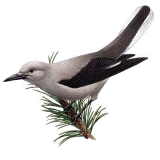Papers in the Biological Sciences
Date of this Version
2000
Abstract
Clark’s nutcrackers (Nucifraga columbiana) were trained to search in a location defined by its geometric relationship to 2 landmarks. Two groups were trained to search at different points along the line connecting the landmarks, and 2 groups were trained to find the 3rd point of a triangle, on the basis of either direction or distance from the landmarks. All groups learned and transferred to new interlandmark distances. However, the constant-distance group learned more slowly, searched less accurately, and showed less transfer than the other 3 groups. When tested with new orientations of the landmarks, the birds tended to follow small but not large rotations. When tested with a single landmark, birds in the half , quarter, and constant-bearing groups searched in the appropriate direction from the landmark, but birds in the distance group did not. These results demonstrate that nutcrackers can learn a variety of geometric principles, that directional information may be weighted more heavily than distance information, and that the birds can use both absolute and relative information about spatial relationships.


Comments
Published in Journal of Experimental Psychology: Animal Behavior Processes 26:4 (2000), pp. 439-453; doi: 10.1037/0097-7403.26.4.439 Copyright © 2000 American Psychological Association. Used by permission. “This article may not exactly replicate the final version published in the APA journal. It is not the copy of record.” http://www.apa.org/journals/xan/